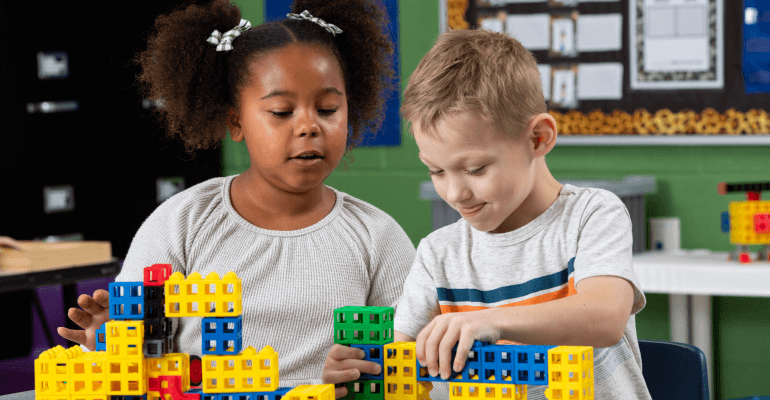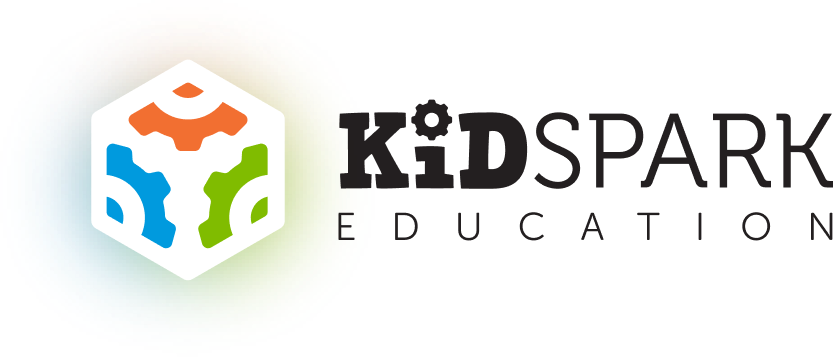
Young students can overcome their fears with hands-on learning that makes learning an enjoyable experience.
Math has a storied reputation in education, with the mere thought of an upcoming math test or a challenging homework problem triggering a fight or flight response in elementary students across the nation. Faced with intimidating math questions, students will often freeze, thus putting their learning at a standstill and their potential for achievement in jeopardy.
Fortunately, the hands-on STEM (science, technology, engineering, and mathematics) programs from Kid Spark Education can alleviate these anxieties and create an engaging atmosphere for students to not only learn math, but also to love math. Our programs are designed to help elementary students develop stronger math skills through fun, engaging, real-world experiences.
By interrupting the pattern of fear and failure early, students can exceed expectations and embrace their bright futures.
Kid Spark Education achieves this shift through the following:
- Hands-on learning
- STEM integration
- Problem-solving
- Collaboration
- Engagement
Let’s jump into the problem and discover how hands-on learning from Kid Spark Education can help.

Elementary Math Scores Decline Dramatically
According to the National Center for Education Statistics (NCES), in 2022, average mathematics test scores for students age 9 declined by 7 points compared to 2020. This drop represents the first ever drop since scores began to be regularly reported, representing the potential for a scary downward trend. Reading scores also showed a drop, going down by 5 points on average, the biggest drop since 1990.
What’s Causing Declining Elementary Math Scores
There’s no doubt that COVID-19 and its aftermath triggered a domino effect of consequences when students abruptly had to transition to remote learning, although the connection between that and falling scores is still being studied thoroughly.
As early as September 2020, the Economic Policy Institute pointed out that the COVID-19 pandemic illuminated pain points that never before had a contingency plan. School shutdowns and subsequent return to school strategies resulted in lost learning time, and the related pressure on teachers caused a teacher shortage that continues through today. Thus, classrooms are full or overflowing, making learning environments even more challenging.
According to NCES Commissioner Peggy G. Carr, Ph.D., “COVID-19 disruptions may have exacerbated many of the challenges we were already facing.” The NCES also showed a more significant drop in scores for lower-performing students, and there’s a clear correlation between lower-income students and poorer performances post-COVID.
Math Anxiety as a Performance Barrier
Math anxiety is a lifelong struggle for many students, yet it remains an understudied phenomenon. One study in Miami-Dade County showed that approximately 93 percent of Americans report having some level of math anxiety.
Students may find themselves in a vicious cycle of anticipating their own failure, says the Child Mind Institute, since they accept the concept that math is important but very difficult. The chances at success at math are slim, they begin to think. This state of heightened anxiety can even affect their memory, making it even harder to learn the subject.
STEM Labs: Taking on Math Education Challenges
With these startling statistics and mounting pressure in mind, teachers face quite the challenge when it comes to planning their math lessons and STEM curriculum. The programs from Kid Spark Education can help teachers by providing an engaging activity that excites the minds of students while integrating math, a subject that previously scared them.
How Kid Spark Education Helps Kids Love Math
Here are five ways Kid Spark Education can help students improve their math skills:
- Hands-on Learning: Kid Spark Education believes that the best way for students to learn math is by doing. Our programs allow students to build, experiment, and apply mathematical concepts in real-world situations, making math more accessible and less intimidating.
- STEM Integration: By integrating STEM subjects, Kid Spark Education creates a dynamic and interdisciplinary learning environment. This approach to education helps students see the relevance of math in their everyday lives and how it can be applied to solve real-world problems.
- Problem-Solving: Kid Spark Education’s programs challenge students to think critically and creatively to solve complex problems. This type of hands-on, problem-solving approach helps students develop problem-solving skills, a critical component of mathematical thinking.
- Collaboration: Kid Spark Education encourages students to work together and collaborate on projects, as many activities are meant to be done in groups. This not only helps students develop social skills but also enhances their ability to think mathematically, as they can learn from each other and share their different perspectives.
- Engagement: Kid Spark Education’s programs are designed to be fun, engaging, and interactive. By making math enjoyable, students are more likely to be interested in the subject and be motivated to learn more. Engagement is key to helping students develop stronger math skills.
Let’s break down each of these key benefits.
Hands-on Learning in Mathematics
It may at first glance seem counterintuitive to be able to orchestrate a “hands-on” activity revolving around math, which seems like such a conceptual subject, but the STEM programs from Kid Spark Education make that a reality. From the earliest Pre-K programs through elementary school and middle school, students will work with manipulatives when completing the Kid Spark programs, and teachers won’t have to stress over supplies for the program, as everything is included.
The National Association of Elementary School Principals reported the following:
“While 46 percent of teachers viewed hands-on projects as an effective learning technique for all students, 54 percent said that this approach is particularly well-suited for students who learn more effectively in non-traditional approaches, particularly visual or kinesthetic learners, slow readers, and students with limited English-language skills.”

Kid Spark Education STEM lab kits provide an accessible option for hands-on projects that can make learning fun and effective for non-traditional learners.
STEM Integration with Project-Based Learning
STEM learning includes the subjects of science, technology, engineering, and mathematics. The STEM-focused programs from Kid Spark Education will bridge the gap between the traditional math skills students need to succeed on their standardized tests and engaging STEM projects that develop critical thinking skills and a love for STEM.
STEM lab programs from Kid Spark Education can help alleviate anxieties about math by focusing on projects that integrate math into other subjects that the students enjoy. The National Association for the Education of Young Children showed success in the project-based approach to learning, allowing students to focus on the process and their success rather than their fears of failure.
Kid Spark Education STEM lab kits connect the dots between the different disciplines of STEM, therefore supporting an integrated approach to learning.
Development of Critical Problem-Solving Skills
Learning STEM is as important as learning to read. As STEM educators will tell you, STEM incorporates key problem-solving strategies that are unlike those in other school subjects.
With Kid Spark Education programs, students are asked to achieve a clear objective while having all the tools and information needed to do so. Students may not even realize how their approach to new challenges is growing with their successful completion of each math lesson.
Promoting Student Collaboration
The elementary school STEM labs from Kid Spark Education can be completed by the students in groups or through other collaborative processes. Students must support one another and work together in order to accomplish their goals, which itself represents a critical skill.
Group work brings together students who have different types of learning styles, including visual, auditory, kinesthetic, and writing, allowing them to support one another rather than get stuck quickly.
Students can also make connections with one another that can continue outside of the STEM project.
Engagement
Sometimes school can feel monotonous to students, and even successful students may be disengaged, simply going through the motions of their regular worksheets or homework without really embracing the topic they’re studying.
STEM labs invite students to comfortably engage with math concepts in a way that’s particularly memorable. The energy of the classroom can lift too, as students will be excited by the prospect of an interactive project that disrupts their typical routine. Students who do not see themselves as “good” at math may also find themselves with an improved attitude as they succeed with the Kid Spark Education programs.

Benefits of Math in STEM Elementary School Programs
In the acronym STEM, math is represented by the last letter. It’s not surprising that many STEM programs first present the science, technology, or engineering aspects, particularly when you consider the prevalence of math anxiety.
However, elementary school math is one of the most foundational subjects of STEM-based learning. Math is used for logical thinking and identifying patterns and should be reframed as a sense-making activity rather than a catalog of formulas that must be memorized and regurgitated, according to the International Journal of STEM.
A strong foundation in math is a key center point of a long-term STEM education and even STEM career, points out the National Council of Teachers of Mathematics. STEM careers are more in-demand than ever, so students who master elementary school math skills thoroughly will be one step ahead when it comes to professional success.
Sample Elementary School Math STEM Lesson
So what does a math project from Kid Spark Education look like in practice? Let’s take a sampling of the Perimeter Curriculum curated for students from third grade through fifth grade. This lesson is meant to take about 120 minutes with the elementary school students in groupings of two to four utilizing the Kid Spark STEM Pathways Lab.
Students will first learn to define perimeter—but not just by reading a definition from a textbook. They will get to work with manipulative blocks and beams to build a square, rectangle, and circle where they can see exactly what the inner and outer perimeters are.

Students are then invited to complete a divergent learning activity where they create a simple floor plan for a house with the blocks and beams. Students will use the design and engineering process that appears throughout the Kid Spark Education curriculum and more broadly in STEM learning.
This is just one math-focused STEM lesson plan from Kid Spark Education that delivers great results for students of all learning styles.
Why Choose Kid Spark for STEM Labs
At Kid Spark Education, we believe that access to STEM education can change lives, and that commitment is apparent in everything we offer, from the thorough lesson plans and professional learning to equity grants and more. Our goal is to see STEM education available to all school-age children in the United States by 2030.
Our STEM labs are guided by the Next Generation Science Standards (NGSS). The NGSS features three parts: scientific and engineering practices, crosscutting concepts, and disciplinary core ideas.
STEM programs can help elementary school students overcome their fear of or disdain for math, a foundational subject that is often avoided rather than embraced fully. Kid Spark Education utilizes hands-on learning, STEM integration, problem solving, student collaboration, and engagement to do so.
Learn More About Math in Elementary School STEM
Math may seem like a scary subject to elementary school students, but with integrated STEM lessons from Kid Spark Education, young learners can experience a comfortable, collaborative atmosphere where they can overcome math anxiety and construct a foundational knowledge on the subject.
Kid Spark Education tailors different programs to align with the goals for each grade level, starting with Pre-K through first grade, continuing with second grade through fifth grade, and offering the highest level programs for students sixth grade through eighth grade.
To get started with our STEM kits for your classroom or to learn more, contact us today.

